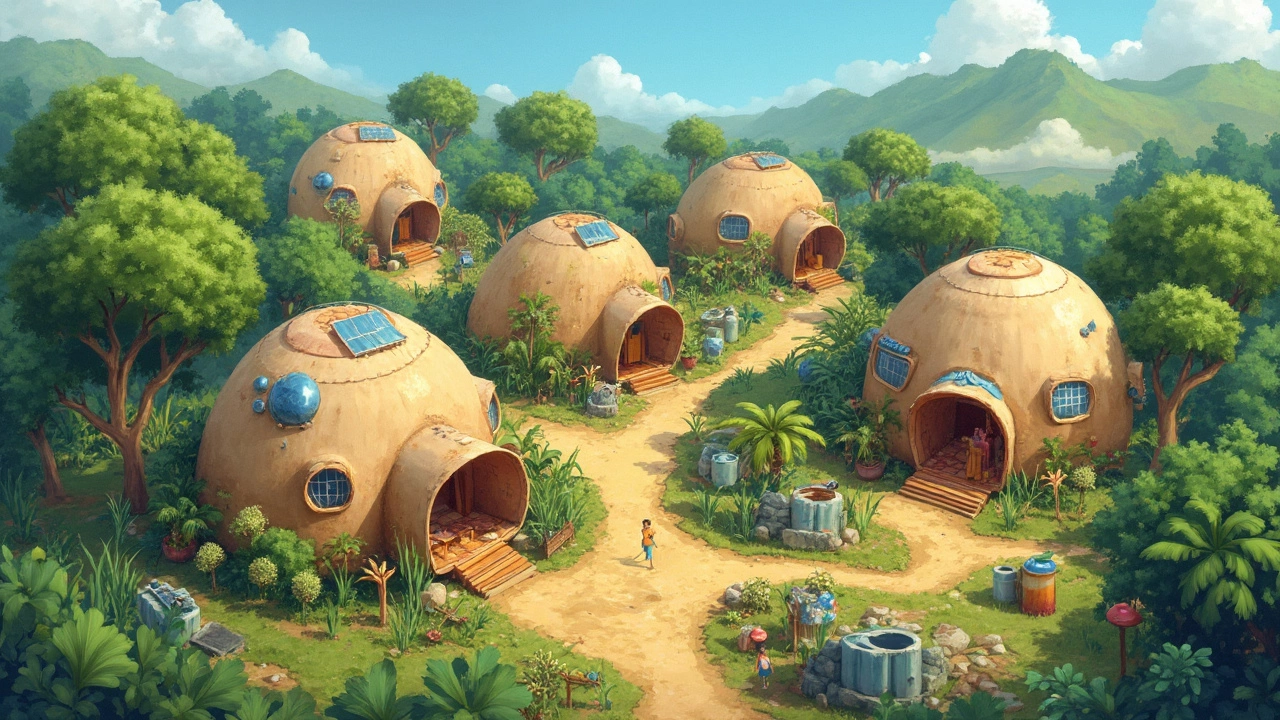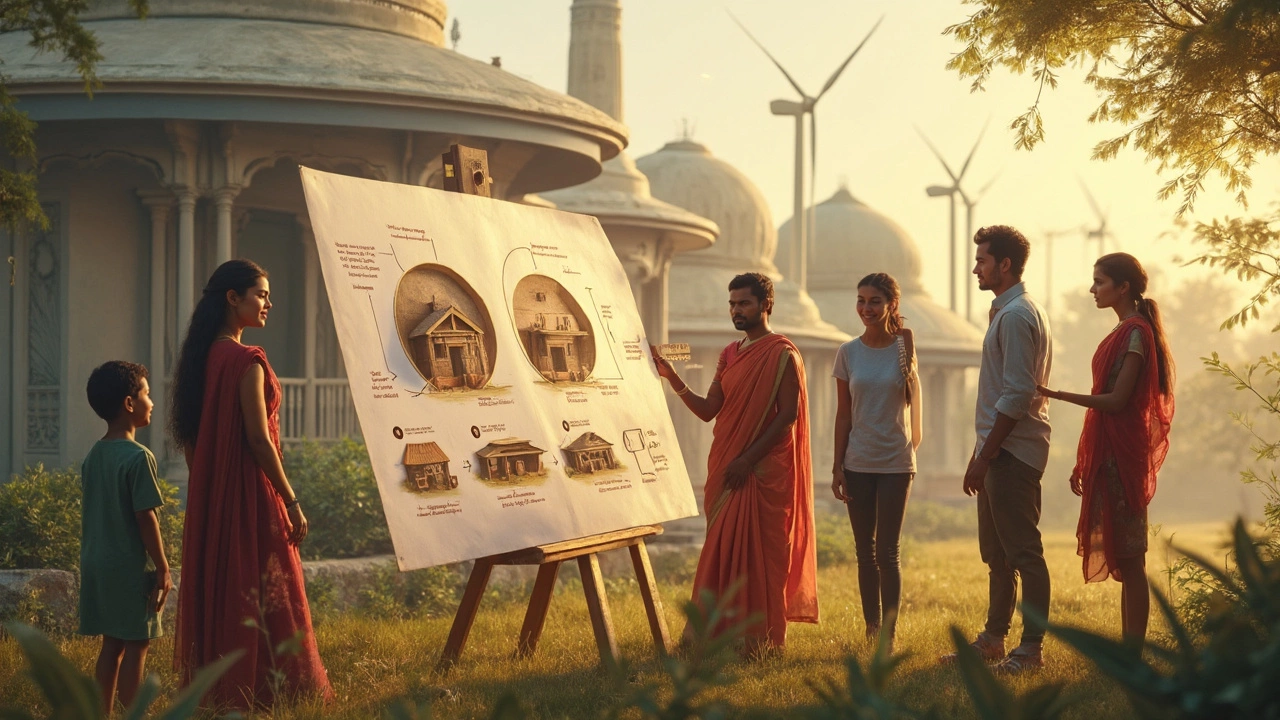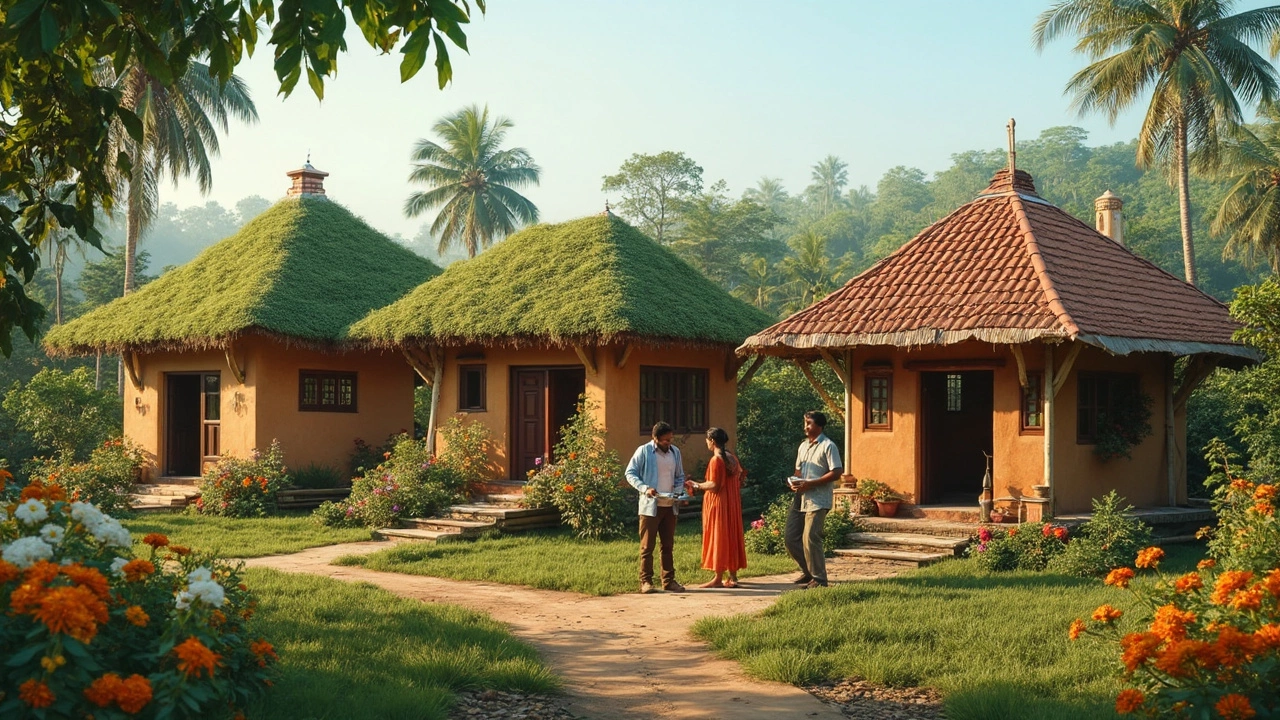Ever wondered why most eco-cottages you see are either square or a basic rectangle? It’s not just a style choice—it’s all about saving money and cutting waste. The less complicated the shape, the fewer materials you need and the easier it is for builders to get the job done right. Fewer corners mean less time, less cost, and way fewer headaches later on.
On top of that, a simple house shape makes it easier to insulate and seal. Want lower power bills? The less surface area on the outside walls and roof, the less heat sneaks in or slips away. This means you’re not just saving when you build, but also every month you live there.
So, if your eco-cottage dream includes both going green and saving green, pay close attention to what shape you pick. The smartest plans start with the outline, not just what color you’ll paint the front door.
- Why Shape Matters for Cost and Efficiency
- The Classic Box: Square and Rectangle Homes
- Round and Dome Houses: Surprising Advantages
- Unique Shapes: When Does Creativity Cost More?
- Tips for Building a Cheap, Green Cottage
Why Shape Matters for Cost and Efficiency
The shape of your house isn’t just about curb appeal—it's a big deal for your budget and daily comfort. When picking a layout for any economical house shape, you want something that’s quick to build, uses fewer materials, and keeps hot or cold air from slipping outside. Every extra bump, angle, or corner costs money—sometimes a lot more than you expect.
Here’s the simple truth: a compact shape, like a square or rectangle, reduces the amount of outside wall and roof compared to the floor space inside. Less wall means less material, cheaper labor, and way less chance for leaks or drafts. In fact, studies show that a basic rectangle can save you up to 18% on exterior materials compared to a sprawling design with lots of corners and jogs.
But it’s not just about wall length. Heating and cooling bills love simple shapes. Why? Because the fewer the nooks and crannies, the easier it is to keep the temperature steady—especially if you want your home to be a true eco-friendly cottage. Less surface area means your insulation works better, and you’re not wasting energy every month.
Check out this quick look at how shape affects costs and energy loss:
| House Shape | Wall Surface Area (sq ft) | Estimated Build Cost ($/sq ft) | Energy Efficiency |
|---|---|---|---|
| Square | 640 | $110 | High |
| Rectangle | 700 | $115 | High |
| L-Shaped | 830 | $125 | Medium |
| Irregular/Multi-Cornered | 950+ | $135+ | Low |
If you’re after a building cost you won’t regret, keep it simple. Want your dream cottage to keep you cozy without monster power bills? Focus on a straightforward design. Fancy corners and odd angles might look cool but they make both your builder and your wallet sweat.
The Classic Box: Square and Rectangle Homes
When people talk about economical house shape for an eco-friendly cottage, it’s almost always the square or rectangle that comes up first. There’s a good reason for that: these shapes use materials in the most straightforward, no-nonsense way. Every wall joins at a right angle, so there aren’t weird corners or curves to slow down your builder or chew through your budget.
Sticking with a box shape cuts down on waste, too. Standard building materials like plywood, drywall, and insulation come in rectangular sheets. If your walls are straight and your corners are square, you won’t end up with a pile of random scraps you can’t use again. That’s not just greener—it’s cheaper.
Here’s a fun fact: engineers have figured out that for a set amount of floor space, a square actually has less exterior wall than a skinny rectangle. Less outside wall means less exposure to cold, heat, and wind, which helps with energy efficiency and lowers your utility bills. That’s a big deal if you want your eco-friendly cottage to work with the weather, not just against it.
| Shape | Outside Wall (feet) | Waste Factor |
|---|---|---|
| 20x20 Square | 80 | Low |
| 10x40 Rectangle | 100 | Medium |
| L-Shaped (20x20x10x10) | 120 | High |
The other win with square and rectangle cottage design? Construction is way faster. Most builders have done this shape hundreds of times, so they can build faster and make fewer mistakes. This keeps labor costs down and shortens the time you’re waiting to move in.
- Choose a footprint that matches standard material sizes (multiples of 4 feet).
- Stick to a single-story design to avoid extra structural costs.
- Plan windows and doors carefully so you don’t lose too much insulation space.
Simple shapes often get called boring, but when you’re counting every penny for that building cost, going boxy is pretty smart. You end up with a solid, cozy, and green home that doesn’t stress your wallet.

Round and Dome Houses: Surprising Advantages
At first glance, round or dome houses might seem more like a design experiment than a smart economical house shape. But here’s the twist: this style has a bunch of real, down-to-earth advantages for anyone dreaming about an eco-friendly cottage.
The biggest perk? Fewer exterior walls. Because the surface area is naturally less than with rectangles or squares, these shapes keep warm (or cool) air inside better. That means lower energy bills—some studies show you could save around 30% on heating and cooling because the air moves more smoothly and doesn’t get trapped in corners.
| House Shape | Surface Area per 1,000 sq ft | Estimated Energy Savings |
|---|---|---|
| Rectangle | ~1,200 sq ft | — |
| Circle/Dome | ~1,050 sq ft | Up to 30% |
Round and dome homes are also strong against wind and storms. No sharp corners means less stress on the structure, so if you’re in a rough weather zone, this could be a game changer. That’s why you’ll see a lot of domes in hurricane-prone areas.
But what about costs? Here’s where it gets interesting. If you’re working with a builder who’s done domes before, you can actually save on materials by needing fewer walls and less roofing. Prefab dome kits often cost less than custom builds for the same square footage, so if you want a cozy, budget-friendly cottage design, domes are worth a closer look. The catch is that not all contractors are experienced with them, so always check their background first.
- Less wasted materials versus corners and straight edges.
- No need for load-bearing interior walls–which means more open space inside for less money.
- Great acoustics (no echoey corners).
For folks who care about sustainable building and lower monthly expenses, round or dome houses stand out. They work especially well for small footprints, so if a tiny eco-friendly cottage is your goal, this shape ticks a lot of boxes. Just don’t forget to double-check if your local building code allows round homes before you start painting that perfect curve.
Unique Shapes: When Does Creativity Cost More?
If you’ve spent any time scrolling through magazines or Pinterest, you’ve seen some wild-looking eco cottages—think A-frames nestled in the forest, even octagonal or hexagonal homes. Creative? Absolutely. But are they economical house shapes? That’s where things get tricky.
Every time you stray from the classic square or rectangle, your cottage usually gets more expensive to design, build, and keep comfy. Here’s why: every angle that isn’t 90 degrees means custom cuts for floors, walls, and even the roof. Builders spend more hours measuring and fitting, and you pay for every minute.
Unusual shapes also gobble up more materials. Imagine framing a round or octagonal room—you can’t just buy standard wall panels and slap them up. Same story for windows and doors; curved or angled walls = higher prices. And insulation is a pain to fit, which means it’s harder to keep the house warm in winter and cool in summer.
| Shape | Estimated Cost Increase | Notes |
|---|---|---|
| Square/Rectangle | Baseline (0%) | Easiest and cheapest to build and insulate |
| A-Frame | +15%-20% | Complex roof angles, more material waste |
| Hexagonal/Octagonal | +20%-30% | Custom lumber and specific engineering |
| Curved/Round (Yurts, Domes) | +10%-25% | Special materials, tricky finishing work |
Sure, a one-of-a-kind cottage turns heads. But before you jump into a complicated shape, ask yourself if it’s worth the higher bills—up front and every year after. Not only does it impact your build budget, you’ll also pay extra to maintain and heat or cool that unique space.
- If you crave character but want to stay on budget, add unique features to a basic eco-friendly cottage shape instead of changing the main outline.
- If you do pick a creative shape, hunt down local builders who’ve actually done it before—learning as you go can be brutal.
- Always get clear price estimates for extra framing, roofing, and insulation. Don’t let a cool sketch become a money pit.

Tips for Building a Cheap, Green Cottage
If you want your eco-friendly cottage to be easy on your wallet and the planet, start with smart choices before you even break ground. The economical house shape makes a huge impact, but that’s just the tip of the iceberg. Let’s talk real ways to keep costs low and comfort high.
- Stick to Simple Shapes: Go for a square or rectangle. These shapes mean less framing, fewer wasted materials, and way easier insulation. Complicated corners eat up building time and cash.
- Choose Efficient Materials: Use local lumber, recycled insulation, and eco-friendly siding. Materials like structural insulated panels (SIPs) often cost less in the long run because they slash your heating and cooling bills.
- Minimize Unnecessary Features: Big porches, fancy bay windows, and odd-shaped nooks might look cool, but they bump up the price in a hurry. Keep your design simple and you’ll save right from the blueprint stage.
- Maximize Natural Light: Orient your cottage so you get more sun in winter and less in summer. South-facing windows can cut your need for lights and even warm the house during cold months.
- Matter of Size: Go for a smaller footprint. With tiny homes, every square foot counts, so double up rooms or keep open-plan living spaces. Less space equals less stuff to buy, heat, and maintain.
Curious about how shapes and materials stack up? Here’s a quick comparison showing rough costs and energy efficiency:
| House Shape | Avg. Construction Cost per Sq Ft | Energy Efficiency (1=Low, 5=High) |
|---|---|---|
| Square/Rectangle | $140 | 5 |
| Dome/Round | $120 - $170 | 5 |
| L-Shaped/Complex | $175+ | 3 |
Another pro tip: look for prefab or modular cottages. They’re built in factories, so they use fewer resources and produce far less waste. And since you pay a flat price upfront, surprise expenses are less likely to pop up.
Building codes might seem annoying, but following the latest energy standards will save you money every single month. You’ll use less power, get better comfort, and sometimes qualify for rebates just by meeting or beating local efficiency rules.
Staying practical with your eco-friendly cottage design doesn’t mean you have to give up personality or comfort. The smartest moves are usually the simplest and easiest to maintain. Every dollar and hour you save during building will pay you back for years to come.
